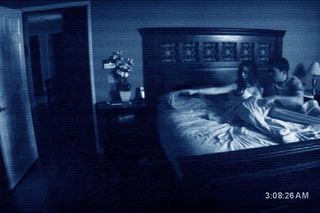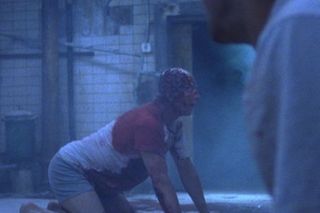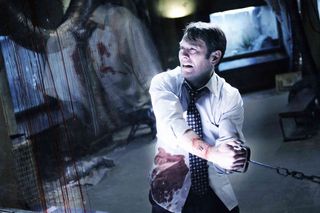The Saw Re-Release Bombed On An Historic Level, Here's Why

As of the time of this writing, the Saw re-release has ranked in as the third worst wide opening at the box office. This is according to Box Office Mojo's records, which reach as far back as 1982. To put this into perspective, a "very wide" release is one that opens in more than 2,000 theaters. So out of the worst 200 films to have opened in the past 32 years, with as wide of an audience as can be expected for a major motion picture, Saw's tenth anniversary re-release opened worse than such films as The Real Cancun, Bandslam, and The Adventures Of Pluto Nash.
Who would have thought that a franchise that used to be the toast of the October film market would bring in such a telling sign about the state of its ultimate legacy ten years on. With the Saw franchise producers eager to bring new life to their monster in the next couple of years, this weekend's showing should be the nail in the coffin of Jigsaw and his apprentices. That judgment doesn't come lightly, but it does ride on the back of three very important factors those very same producers should keep in mind if they're serious about resurrecting Jigsaw.

The Tastes Of Horror Crowds Change Fast
The Saw franchise ran for seven years straight, with only one real "bomb" among them. In its wake, the horror landscape managed to jump onto the bandwagon of a new genre. Thanks to Saw, the torture porn subgenre of horror was born and flourished, producing such copycats as Hostel, the remake of Funny Games, and even bombs like Captivity. If you weren't a fan of these types of movies, there was plenty of reason for you to fear their popularity. That all changed in September of 2009, when audiences discovered something much creepier: ghosts in plain sight.
With the smash hit success of Paranormal Activity, the industry ushered in a resurgence of the found footage subgenre. With an impressive marketing campaign and killer word of mouth, horror fans shifted their attention to the new and shiny toy on the block. This was probably the reason why a month later, Saw VI took its biggest hit at the box office. What scares us can change at a faster rate, if we're exposed to it at a quick enough interval – something that even Paranormal Activity learned the hard way. With seven years of increasing amounts of blood and complexity, Saw's audience outgrew it quicker than the horror franchises of the 80's.

People Know The Twist, So It's No Longer Thrilling
As mentioned before, the Saw franchise pretty much forced itself into a quicker chain of evolution than most successful horror films before it would ever dream of. As a result, each Saw film would need to be more brutal, and more efficient than the last, in order for the franchise to stay relevant. When your franchise relies on a story that needs to be told, this innovation is much easier to come by, thus allowing you to get more mileage out of a very similar release schedule. Two big examples of such successes are the Friday The 13th and Nightmare On Elm Street franchises.
CINEMABLEND NEWSLETTER
Your Daily Blend of Entertainment News
Both managed to rack up decent kill counts, as well as more innovative traps and offings of their characters. But both had the story to back it up, which made the initial films probably the most loved in their entire line. Saw's story is so threadbare that you could probably condense all seven "plots" into one cohesive narrative, and not miss anything; plus, once you know that Jigsaw is still alive at the end of Saw, it robs the film of all the dramatic tension that came from the moment when you first realized, "oh shit, that guy was alive this whole time?!" Of course, this leads to the biggest problem of Saw's rapid evolution...

The Saw Franchise Has Burned Itself Out
While Saw was an innovative enough concept to become an overnight sensation in 2004, its sequels ran into the same problem any other franchise would: how do you keep the mythology going indefinitely? For the first couple of follow ups, Saw still had some gas in the tank, thanks to the continuing retroactive continuity ("retcon" for short) that would go into each film. We learned that Jigsaw had apprentices, we learned that he was in fact dying and that he created his traps after being inspired by his own struggles with finding life worth living.
As time went on though, the apprentices numbered too many, the mythos was spoiled to the point where even Jigsaw went against his own principles, and by time Saw: The Final Chapter came about, it threw a Hail Mary of a plot twist by bringing Cary Elwes back into the fold, and even that fell short of what those in charge were expecting. With every installment, the franchise left itself fewer options to continue its legacy, and the attention to plot it ditched in favor of gore and visceral thrills came back to bite them in the ass. All the while, the first film aged more horribly than Star Trek: The Animated Series.
So what's the ultimate lesson to be learned here? Some might say don't build a franchise around the sole purpose of putting people in more perilous and impossible circumstances. Others might say build your mythology slowly but surely into something worth a damn to your fans. Overall, the big lesson Saw should teach is is while it's fine and well to create a cash cow that gets milked on an annual basis, the best way into an audience's nightmares is if you give them something they feel is palpable enough to stick with them. If you scare your audience the right way, you can keep them peeking out from under the covers for decades.

Mike Reyes is the Senior Movie Contributor at CinemaBlend, though that title’s more of a guideline really. Passionate about entertainment since grade school, the movies have always held a special place in his life, which explains his current occupation. Mike graduated from Drew University with a Bachelor’s Degree in Political Science, but swore off of running for public office a long time ago. Mike's expertise ranges from James Bond to everything Alita, making for a brilliantly eclectic resume. He fights for the user.
Most Popular






